Take a bite out of Laos
A few days after Gerni left to go back home, I showed up at the Bangkok train station with the last of my Baht in my wallet, ready to splurge on a 1st-class sleeper car for the overnight train to Vientiene. But they were all booked. Okay, no problem — I'll just settle for a nice seat in second class. But those were all booked too. I snatched up the last seat in third class, and climbed aboard the 15-hour train to find my seat in what looked like a really awful subway car designed for midgets, scattered with people sleeping in every available space. After a rough night spent trying to prevent a crazy old man from sleeping and drooling on my shoulder, I made it to the Thai-Lao border where I shelled out 35 bucks for a visa to Laos, and arrived in Vientiene a few minutes later.
Throughout its history, the country of Laos has been the little white ball in a global game of ping-pong, getting passed around and taken over numerous times. In the last 75 years, it has been part of the Kingdom of Siam, integrated into French Indochina, occupied by the Japanese, established an independent kingdom, and again declared a French satellite state, seen military coups and counter-coups, had elections rigged by the CIA, declared itself an independent country again, became under-the-influence of Vietnamese communism, was heavily bombed by the United States, had hundreds of thousands of people sent to "re-education" camps, and became an independent democratic country. The history of Laos is staggeringly complicated, and I struggled to grasp exactly how its confusing history has affected the mentality of and culture of the country.
As I arrived in the capital city Vientiene, some of the effects of the country's unique history were easy to see. Gorgeous French colonial mansions shared the streets with blocky structures of communist concrete. Ancient curved-roof Laotian temples gazed down upon vendors selling baguettes and paté. Lao women in long patterned skirts sat at European-style sidewalk cafés along extra-wide communist-era boulevards. Luxurious French restaurants stand side-by-side with scrappy but delicious Lao hole-in-the-wall joints. As I explored the relaxed atmosphere of Vientiene, I was fascinated the unique cultural mix, which is enhanced by the employees of all of the foreign embassies and consulates spread around the small town. Here's a shot of one of many unlikely cultural matchups, the Lao take on the Arc de Triomphe:
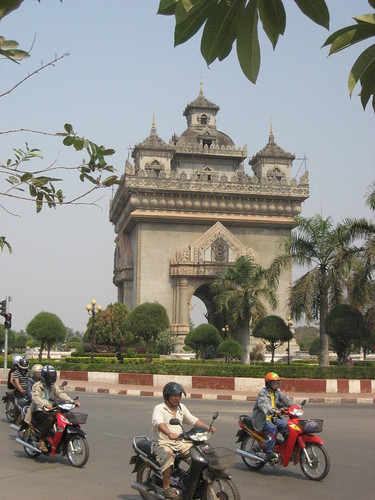
With limited time to spend in Laos, I left the capital for a long backbreaking night on a local bus headed north to Luang Prabang. I arrived at 4:00 am, which is probably the worst time to get to a city. To make matters worse, I was befriended by a spunky early-morning jogger who wanted to practice his broken English (and annoy the living crap out of me in the process) as I walked in the dark through Luang Prabang, desperately looking for a room. The city's hotels were stuffed to the brim, but a long three hours of searching finally brought me to an affordable and vacant room — my new friend still jogging in place alongside me as I checked in.
After a much-needed nap, I was up and out checking out the beautiful colonial architecture of Luang Prabang, the entirety of which is protected as a Unesco World Heritage Site. Built largely under French influence and still well-preserved, Luang Prabang has a really different character from the rest of Laos, and the rest of Southeast Asia as a whole. The place was mobbed with tourists, many of whom were expats living in Vietnam on vacation in Laos during Tet, the Vietnamese New Year. Despite all the tourism, I loved exploring back alleys, the numerous historic temples, and the fascinating European-Asian feel of the town.
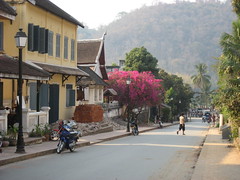
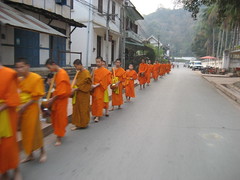
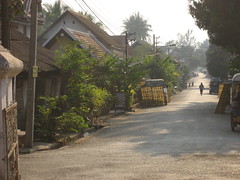
Like the rest of Laos, the French influence has left another big stamp on Luang Prabang: the people can cook like champs. I went on a serious culinary tour while in Luang Prabang, from relaxing with pastries and a newspaper in the comfortable European-style cafes, to dabbling in the local cuisine. Food in Laos is generally really light and fresh, not drenched in oil like a lot of the food in Asia. At several restaurants, I had làap, a delicious minced meat dish with greens and a handful of fresh basil leaves added to the mix. I also enjoyed tôm yám, a fish and lemongrass soup. Beerlao, the national beer, is one of the best beers in Asia, and for a change of pace, I sometimes stopped off at one of the town's many reasonably-priced wine bars. Desserts on offer were equally delicious — my favorites were pumpkin-coconut creme brulée, and homemade tapioca pudding topped with sliced bananas.
I also tried the Luang Prabang town specialty Jaew Bong, a paste made from ground chili and buffalo skin, which was prefaced on the menu with a warning about how absurdly spicy it is. Curious, I took the plunge and after a minute of chewing, the spice seemed pretty run-of-the-mill. But then, time suddenly came to a screeching halt. Waiters carried trays mid-stride. People around me sat with bites on forks held frozen near their mouths. Then someone entered the restaurant, and stuffed an entire orchard full of habañero peppers into my mouth and forced me to chew. A play button was pressed, and time started up again.
Holy... sh...
Something's... not... right...
With... oh.. no...
It's... so... spicy...
Oh.. no... oh.... man...
I can't... oh... it's... holy... god...
I glanced over at the waiter who smiled and waved as tears streamed from my eyes, and snot poured from my nose. I tried to douse my mouth with water. Then wine. Then rice. Then water. Then wine. Then rice. And it just kept burning. This Jaew Bong stuff made Thai, Indian, and Mexican food seem as tame as a jar of baby food. I seriously thought I was going to have to go to the hospital.
My favorite restaurant was a place called Tamarind, run by a Lao-Australian couple, which gives visitors an opportunity to both eat Lao cuisine and learn about it in the process. I ate there for lunch one day where I tried a sampler platter of traditional Lao food including dried buffalo meat, pickled vegetables and bamboo, spicy Luang Prabang sausage, and flavored pastes wrapped in lettuce. I returned for a Friday night dinner party where twelve of us sat at a big table where we spent a few hours chatting, drinking delicious Beerlao, and enjoying a three-course Laotian meal called Pun Pa as the owners explained the significance, history, and preparation of each dish. The food and company were wonderful, and the whole meal only set me back seven bucks. Not too shabby.
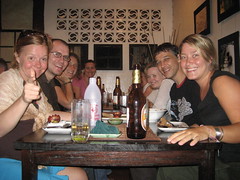

In between delicious meals, I did my best to get out of town once in a while. I randomly ran into my British friend Liz, who I traveled with for a few days way back in India. Along with her current traveling companions, we hopped in a tuk tuk and sped off through the thatched huts and rice fields of the countryside to visit a nearby waterfall which was truly spectacular. It had three big falls and a few hundred smaller ones, with shimmering turquoise-green pools laying between them like terraces. The best part was swimming around and jumping off of some of the smaller falls.
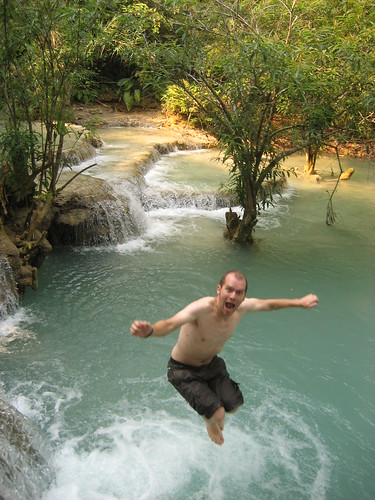
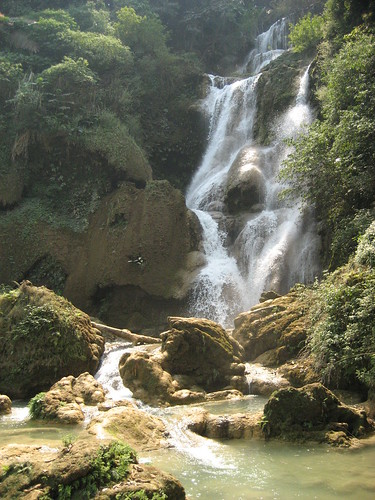
Later, I paid a visit to the Luang Prabang Provincial Museum, which had a really nice exhibition of contemporary art, which had a handful of excellent pieces by Luang Prabang artists about dealing with the rapid modernization of Laos. The main part of the museum was a recreation of the former king's palace, showing off his impressive collection of artwork. The highlight was definitely the Secretariat Room, which proudly displayed gifts he received from world leaders during the middle of the 20th century: from Japan, the key to the city of Tokyo and minimalist pots; from China, elaborate woven-silk scroll landscapes; from Russia, awkward soviet trinkets and a carved wooden box; from India, intricately carved ivory boxes; from Burma, patterned silver tea sets; from Australia, a wooden boomerang(!); and from the United States, a scale model of an NASA spacecraft, and a flag of Laos brought to the moon on the Apollo 11 mission. It made me wonder where all the awesome gifts the US Presidents have received over the years are stored — does anybody know?
The rest of my time in Luang Prabang was spent exploring the twenty-some temples around town, watching the neighborhood kids splash around in the river, helping a monk practice his English over the course of a few afternoon sessions, catching stunning sunsets over the Mekong, watching movies and reading books, and hanging out with people I met around town. I spent a few nights with Liz, my friend from my travels in India, and had some great beer-and-Uno sessions with Veronica and Erika, two delightful girls from San Francisco. One night, I rounded up 28 other people and we all squeezed into a truck for a night out at a sketchy Chinese bowling alley, the only place in town open later than midnight.
After a week of hanging out, I decided I better get moving, so I took the bus back to Vientiene in order to get a visa for Vietnam. I ended up in the bottom compartment of a double decker bus with a bunch of Lao guys who spent the eight hour bus ride getting hammered on lao lao (rice whiskey). Something about the curvy road made everyone on the bus sick, and about half the people threw up along the way. Barf bag in hand, it took a serious mental effort not to lose my lunch, and I was thrilled when the Pukemobile finally arrived back in Vientiene.
The following morning, I went to the Vietnam Embassy where I finally got my Vietnamese visa, which I wasn't able to get earlier because the embassy was frustratingly closed the whole week of Tet. With visa in hand, I decided to make a quick stop in nearby town of Vang Vieng before leaving the country. Considered to be the party capital of Laos—which isn't saying much—I wasn't sure if I really wanted to visit Vang Vieng. I had heard about the magic mushroom milkshakes and ubiquitous TV bars where dazed travelers spend hours watching episodes of Friends, and it didn't sound too appealing. I decided to go anyway, and was stoked to find two cool people on the bus—Brett, a trekking instructor and avid rock climber from Vail, and Becca, an stage actress from England—who were planning to stay a few miles outside of town at Vang Vieng Organic Farm.
The three of us arrived at the farm and settled in, and it was clear that the place was a world away from the party scene over in Vang Vieng. The farm mostly grows mulberry trees, which are used for tea, and used to feed silk worms and goats which in turn provide clothing and other food. Travelers are encouraged to volunteer at the farm, which is also doing amazing things for the surrounding village by building a community center and library, and by funding a school bus for kids who live outside the village. My fellow farmhands were all really cool people who I got along with really well, and I ended up sticking around the farm for a week. The atmosphere around the farm made it easy to stay too — the shining green mulberry fields and limestone mountains surrounding the farm were really beautiful, and families from the nearby village would come to the river next to the farm to play and bathe each night.
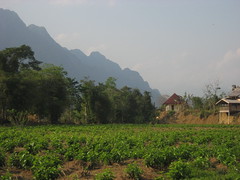
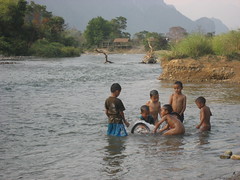
On a few nights, I went along with a bunch of the farm gang to help out at the nearby village school, which was started up by a Korean volunteer organization in conjunction with the organic farm. Since most of the village kids work on their parents farms during the day, the classes take place at night, and were divided up into two sections by age. I struggled helping the younger kids (age 4-12) learn the alphabet from awkward Korean-English workbooks, but once the older kids (age 13-20) class came around, I got into the groove of things. Led by my friend Brett who volunteered to teach the classes for a few weeks, the older kids classes were really great. Many of them were shockingly passionate about learning English, and seemed truly appreciative as we helped them understand new words and phrases. The school is completely voluntary, and 50 of them pour in every night with a hunger to learn from the foreign volunteers who show up every night to teach.
I also volunteered to make a good quality map of the farm, outlining not just the locations, but also the purposes of each building and highlighting volunteer opportunities at each stop along a self-guided tour. With the help of Becca and Brett, we got as much information we could about each part of the farm, and as a result, became much more connected with the overall vision of the farm. The map took forever, but it was really satisfying to be designing something again, which I haven't really done since I left my job eight months ago.
Although I didn't really get into the party scene too much, I did take part in Vang Vieng's biggest attraction: tubing down the river. Becca and I rented tubes one day and set off from the farm down the river. Along the banks of the two hour trip down to Vang Vieng are about twenty bars, each set up with zip lines and rope swings into the river. Although I was worried it was going to be gimmicky and stupid, I absolutely loved the tubing trip. There are few better ways to spend a day than to lazily drift down a river under the warm sun with a Beerlao in hand, looking up at the unbelievable limestone peaks soaring overhead, taking breaks to swing around on high-flying rope swings.

I had planned to stay two or three days in Vang Vieng, but I ended up there for an entire week thanks to the awesome group of friends I made at the farm. Each night we would gather for organic vegetable curry or spring rolls, chat and play drinking games, and each morning we would feed the farm's crazy-cute baby goats and get mulberry pancakes and mulberry milkshakes for breakfast. It was an awesome and unforgettable week, and I would have loved to stay longer, but with less than two months left to get to Berlin to meet my parents, I knew I had better get going.
Sadly, I only had time to see a few places in Laos and didn't really get a chance to dig in and get a good feel for the country as a whole. One area I'm sad I missed is the northeast part of the country, which is one of the most heavily bombed regions on earth, due to United States B-52s dropping thousands of pounds of explosives on the area during the Vietnam War on bombing runs to and from Thailand. The area is still plagued with landmines and unexploded bombs, many of which are unbelievably used to build houses; other travelers I met who went to the area reported seeing houses in villages built on stilts made of unexploded bombs. My knowledge of the Vietnam War is limited, and I would have liked to go there in order to learn more about the role of Laos in the war. It is definitely strange to travel to countries where thousands of people have been killed by your own countrymen, and the effects of the war are still visible all around. It is also humbling to have the local people accept me with open arms, despite a far-less-than-perfect track record with Americans.
Speaking of which, after a quick stop back in Vientiene, I climbed aboard a bus headed somewhere I never pictured I'd visit: Vietnam.
I got to the bus station and boarded the bus to Hanoi early in order to ensure I got a seat on the first-come first-serve bus. After more than an hour of staking my claim to a seat, I was forced out by the asshole driver, who gave my spot to his friends who then refused to give my seat back, not making eye contact and pretending they couldn't hear me yelling at them. As a result, I had no choice but to sit on a tiny plastic stool in the aisle for the 25-hour trip to Hanoi. It was probably the most uncomfortable 25 hours of my life, but it was definitely improved by the really nice Canadian people I met on the bus who offered me time on their seats to give me a break from sitting on the painful stool. At 2:30 am, the Bus From Hell got to the Laos-Vietnam border where we had to wait four hours for the border to open. Most people tried to sleep in the bus, but as I had no seat, I went outside and climbed atop the bus with the other people who didn't get seats and slept up there for a few hours. After crossing the border and more than an entire day spent sitting in the filthy and narrow aisle of an awful bus, I finally made it to Hanoi last night.
I'm here in Hanoi now, which has been really amazing so far. The city packed with full-on Asian experiences, but I'll leave Vietnam for the next post. As always, thank you so much for reading. Wish me luck on my next long journeys — I don't know if my body can handle another one like I had yesterday!
--Ryan
Photos updated: I've got most of them up, but I haven't sorted them yet. I'll get on that one of these days and erase this message once I do.
4 Comments:
That spicy bong food sounds pretty intense, my friend! Maybe avoid that one in the future.
Glad to hear you're having such wild times, I envy your experiences. Soon enough, but latin american-style. Still no word on Mex. City.
I've heard vietnam is very fun, are you going through siberia on your way to Germany?
I loved the organic farm. That sounded great. I'd love to go there and spend a week or so.
love it! favorite so far has been the attack-monkeys. this is one of the few blogs i've read consistently over the past half-year. :)
remember ribbed-sweater? he's on his way over tomorrow (3/20).
-pants
this website is so amazing, all my friends are checking it every day.
any more 1984 experiences?
Post a Comment
<< Home